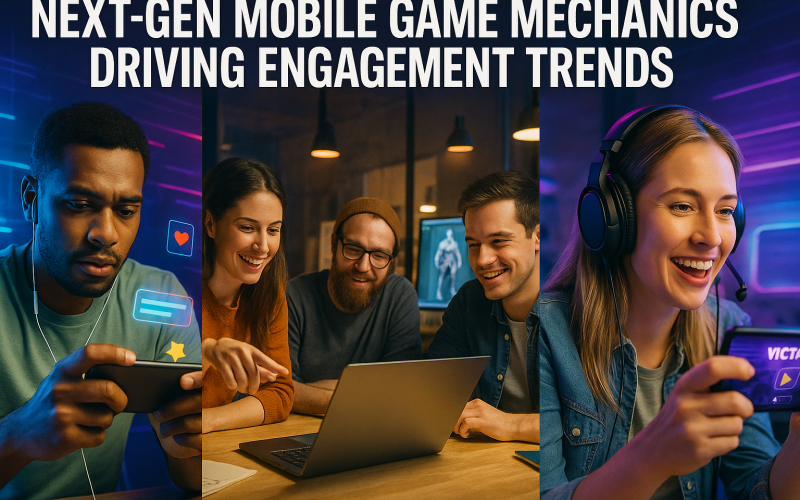Introduction
Mobile gaming has changed a lot over the years. What started as simple games on your phone is now a huge industry with millions of players worldwide. As mobile gaming continues to grow, game developers are using next-gen mobile game mechanics to make games more fun and engaging. These new mechanics help players stay interested in the game and come back to play again. In united states in 2025, game mechanics like augmented reality (AR), virtual reality (VR), artificial intelligence (AI), multiplayer options, and more are making games exciting. This article will explore these next-gen features and how they are driving mobile game engagement trends.
What Are Next-Gen Mobile Game Mechanics?

Next-gen mobile game mechanics like PUBG Battlegrounds, Call of Duty Warzone, person shooters, and battle royale games are new features in games that use technology to improve the gaming experience. These features make games more fun and keep players playing for longer periods. For example, AR makes the game feel like it’s happening in the real world, while AI helps games learn about the player’s preferences. By adding these features, game developers create more interactive and engaging games.
In 2025, these mechanics are helping game developers create immersive experiences that players find immersive and enjoyable. They make games feel fresh and encourage players to keep playing, whether they are exploring virtual worlds or connecting with friends.
Key Next-Gen Mobile Game Mechanics Driving Engagement

1. Augmented Reality (AR)
One of the most exciting changes in mobile video games is the use of augmented reality (AR). AR combines the game world with the real world. Players can see virtual elements placed over the real world using their phone’s camera. This creates an interactive experience where players can interact with the world around them while playing the game.
AR mechanics make games more exciting and social. For example, Pokémon Go lets players go outside to find and catch virtual creatures. In 2025, AR is being used even more creatively to make games more fun and interactive.
Why AR Is Important:
- Increases immersion by blending the real world with the game.
- Makes the game more interactive and fun.
- Encourages players to explore the real world while playing.
2. Social and Multiplayer Features
Mobile games in 2025 are all about connecting with others. Multiplayer mechanics let players join games with their friends or compete against others. This makes the game feel more social and enjoyable. Features like in-game chat, team challenges, and real-time competitions keep players engaged by allowing them to interact with others.
Games like Fortnite and Clash Royale have set the standard for multiplayer experiences. Players can join teams, chat, and compete together in exciting matches. These social features help keep players interested and encourage them to come back for more.
Why Social and Multiplayer Features Matter:
- Builds a sense of community and belonging.
- Encourages players to return and engage with others.
- Offers more ways to interact and compete.
3. AI-Driven Personalization
Artificial intelligence (AI) is making games more personalized. AI can adjust the game to suit how the player is playing. For example, it might change the difficulty level based on how well the player is doing. AI can also recommend challenges or rewards based on the player’s past actions, making the game feel more tailored to each person.
Next-gen games are using AI to create unique experiences for each player. This keeps the game fresh and makes players feel like the game understands their preferences.
Why AI is Important:
- Customizes the game experience to fit the player.
- Adapts the game to keep things challenging and fun.
- Makes players feel like the game is unique to them.
4. In-Game Economies and Virtual Goods
In mobile games, virtual economies are systems where players can earn, buy, or trade in-game items like costumes, skins, or power-ups. These items can make the game more fun, and some players choose to buy them through microtransactions.
In the next generation of games, blockchain and NFTs (non-fungible tokens) are being used to make these virtual goods more valuable. Players can own these items and even trade them across different games.
Why In-Game Economies Matter:
- Offers rewards and customization for players.
- Makes the game more enjoyable by allowing players to earn virtual goods.
- Introduces new ways to make money for game developers.
5. Progression Systems and Rewards
Next-gen mobile games are making progression systems more interesting. In the past, players would just level up as they played. Now, games offer more than just level-ups. They provide rewards, achievements, and special items that players can earn by completing tasks.
Games like Call of Duty Mobile and Candy Crush offer exciting rewards for reaching milestones or completing challenges. These reward systems keep players motivated and excited to continue playing.
Why Progression Systems Matter:
- Keeps players motivated to keep playing.
- Offers rewards that make the game feel rewarding.
- Helps build long-term player engagement.
6. Cross-Platform Play
Cross-platform play allows players to play together, no matter what device they are using. For example, a player on a mobile device can play with or against someone on a PC or console. This feature is becoming more common in 2025, as it makes the game more accessible and creates a larger player base.
Games like Fortnite and Minecraft already offer cross-platform play, and more games are following suit. This feature gives players the flexibility to play on any device, which makes the game more enjoyable and less restrictive.
Why Cross-Platform Play Matters:
- Expands the player base, allowing more players to join the game.
- Makes it easier for friends to play together, no matter what device they use.
- Increases the game’s popularity and longevity.
Future of Mobile Game Mechanics

Looking ahead, mobile game mechanics will become even smarter and more seamless. AI-driven content generators may craft new levels and challenges on the fly, based on each player’s tastes. Cloud streaming will allow high-end graphics and complex physics on any device. Cross-platform play will unite mobile, console, and VR users in shared worlds. Wearable haptics and mixed-reality glasses could let you “feel” and “see” game elements in real space. As these tools mature, mobile games will push engagement to new heights, offering living worlds that evolve with every player’s touch.
Comparative Table: Next-Gen Mobile Game Mechanics Driving Engagement
| Game Mechanic | Description | Benefits | Popular Examples |
|---|---|---|---|
| Augmented Reality (AR) | Combines virtual elements with the real world using a mobile device’s camera | Increases immersion, interactive gameplay, social engagement | Pokémon Go, Harry Potter: Wizards Unite |
| Social and Multiplayer | Includes features for connecting, competing, and collaborating with other players | Enhances community building, long-term player retention | Fortnite, PUBG Mobile, Clash Royale |
| AI-Driven Personalization | Uses AI to tailor the game experience to individual player preferences and behaviors | Creates unique experiences, adapts gameplay difficulty | The Elder Scrolls: Blades, FIFA Mobile |
| In-Game Economies & Virtual Goods | Integrates in-game currencies, rewards, and virtual assets like NFTs | Creates monetization opportunities, boosts player engagement | Roblox, Fortnite, Clash of Clans |
| Progression Systems | Features levels, achievements, and rewards to encourage continued play | Keeps players motivated, boosts long-term retention | Call of Duty Mobile, Candy Crush Saga |
| Cross-Platform Play | Enables players to interact across different devices and platforms | Expands player base, provides flexibility for players | Fortnite, Minecraft, Apex Legends |
Conclusion
The future of mobile gaming is exciting, with next-gen mechanics like AR, AI, multiplayer features, and cross-platform play leading the way. These innovations help keep players engaged, improve their experience, and make the games more enjoyable. By using these mechanics, game developers can create more immersive and rewarding games, ensuring that players will stay connected and continue to enjoy their favorite games.










